最新微观经济学选择题100道答案
微观经济学mooc测试题及答案

微观经济学mooc测试题及答案一、选择题(每题2分,共10分)1. 微观经济学主要研究的是:A. 宏观经济现象B. 个体经济单位的行为C. 政府经济政策D. 国际经济关系答案:B2. 需求曲线通常表示为:A. 水平线B. 垂直线C. 下降线D. 上升线答案:C3. 边际效用递减原理指的是:A. 随着消费的增加,总效用增加B. 随着消费的增加,边际效用增加C. 随着消费的增加,边际效用减少D. 随着消费的增加,总效用减少答案:C4. 完全竞争市场的特征不包括:A. 产品同质化B. 买卖双方数量众多C. 买卖双方对价格有影响D. 没有进入和退出障碍答案:C5. 机会成本是指:A. 放弃的最低价值B. 放弃的最高价值C. 放弃的中间价值D. 放弃的任何价值答案:A二、判断题(每题1分,共5分)1. 价格弹性是衡量需求量对价格变化的敏感程度的指标。
(对)2. 边际成本在完全竞争市场中等于平均成本。
(对)3. 垄断市场下,企业的利润最大化产量是边际成本等于边际收益时的产量。
(对)4. 公共物品具有非排他性和非竞争性。
(对)5. 外部性是指个体经济单位在生产或消费活动中对第三方产生的非市场影响。
(对)三、简答题(每题5分,共10分)1. 什么是价格歧视?请举例说明。
答案:价格歧视是指同一产品或服务对不同消费者或不同购买数量收取不同价格的行为。
例如,电影院对学生和成人收取不同的票价。
2. 请解释什么是消费者剩余,并给出一个例子。
答案:消费者剩余是指消费者愿意支付的价格与实际支付价格之间的差额。
例如,如果一个人愿意为一杯咖啡支付5元,但实际上只支付了3元,那么他的消费者剩余就是2元。
四、计算题(每题10分,共20分)1. 假设某商品的供给函数为Qs = 10P,需求函数为Qd = 50 - 2P,求市场均衡价格和均衡数量。
答案:将供给函数和需求函数相等,即10P = 50 - 2P,解得P = 4。
将P代入任一函数求得Q,Q = 50 - 2*4 = 42。
微观经济学考试题及答案

微观经济学考试题及答案一、单项选择题(每题2分,共20分)1. 需求弹性的计算公式是:A. 需求量的变化百分比 / 价格的变化百分比B. 价格的变化百分比 / 需求量的变化百分比C. 需求量的变化百分比 / 收入的变化百分比D. 收入的变化百分比 / 需求量的变化百分比答案:A2. 完全竞争市场中,企业在短期内实现利润最大化的条件是:A. MR = MCB. MR = ACC. MR = ARD. MR = AVC答案:A3. 价格歧视的类型不包括:A. 一级价格歧视B. 二级价格歧视C. 三级价格歧视D. 四级价格歧视答案:D4. 边际成本曲线与平均成本曲线的交点表示:A. 企业利润最大化的产量B. 企业亏损最小的产量C. 企业成本最低的产量D. 企业产量变化的转折点答案:C5. 以下哪项不是外部性的表现形式:A. 正外部性B. 负外部性C. 内部性D. 外部性答案:C6. 消费者剩余是指:A. 消费者愿意支付的最高价格与市场价格之间的差额B. 消费者实际支付的价格与市场价格之间的差额C. 消费者愿意支付的最高价格与实际支付的价格之间的差额D. 市场价格与消费者实际支付的价格之间的差额答案:A7. 洛伦兹曲线是衡量:A. 收入分配的公平性B. 收入分配的效率C. 收入分配的稳定性D. 收入分配的波动性答案:A8. 以下哪项不是公共物品的特征:A. 非竞争性B. 非排他性C. 可分割性D. 非盈利性答案:C9. 供给曲线向右下方倾斜的原因是:A. 价格上升,供给量增加B. 价格下降,供给量减少C. 价格上升,供给量减少D. 价格下降,供给量增加答案:A10. 以下哪项不是影响需求的因素:A. 消费者偏好B. 消费者收入C. 生产成本D. 替代品价格答案:C二、简答题(每题10分,共30分)1. 简述边际效用递减规律的含义及其对消费者选择的影响。
答案:边际效用递减规律指的是随着消费某种商品的数量增加,从每增加一单位商品中获得的额外满足(即边际效用)逐渐减少。
微观经济学试题及答案
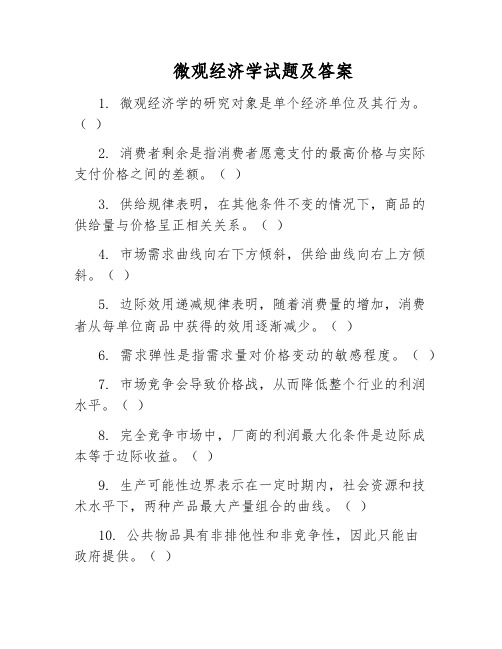
微观经济学试题及答案1. 微观经济学的研究对象是单个经济单位及其行为。
()2. 消费者剩余是指消费者愿意支付的最高价格与实际支付价格之间的差额。
()3. 供给规律表明,在其他条件不变的情况下,商品的供给量与价格呈正相关关系。
()4. 市场需求曲线向右下方倾斜,供给曲线向右上方倾斜。
()5. 边际效用递减规律表明,随着消费量的增加,消费者从每单位商品中获得的效用逐渐减少。
()6. 需求弹性是指需求量对价格变动的敏感程度。
()7. 市场竞争会导致价格战,从而降低整个行业的利润水平。
()8. 完全竞争市场中,厂商的利润最大化条件是边际成本等于边际收益。
()9. 生产可能性边界表示在一定时期内,社会资源和技术水平下,两种产品最大产量组合的曲线。
()10. 公共物品具有非排他性和非竞争性,因此只能由政府提供。
()二、选择题(每题2分,共20分)1. 微观经济学的研究对象是:()A. 整个国民经济B. 单个经济单位及其行为C. 企业内部管理D. 国际经济关系2. 消费者剩余是指:()A. 消费者愿意支付的最高价格与实际支付价格之间的差额B. 消费者实际支付的价格与最低购买价格之间的差额C. 消费者愿意支付的最高价格与最低购买价格之间的差额D. 消费者实际支付的价格与最低购买价格之间的差额3. 供给规律表明,在其他条件不变的情况下,商品的供给量与价格呈:()A. 正相关关系B. 负相关关系C. 无关关系D. 不确定关系4. 需求弹性是指需求量对价格变动的敏感程度,其取值范围是:()A. 0到1B. 1到无穷大C. -1到无穷大D. -1到05. 市场竞争会导致:()A. 价格稳定B. 价格波动C. 价格上升D. 价格下降6. 完全竞争市场中,厂商的利润最大化条件是:()A. 边际成本等于边际收益B. 边际成本等于平均成本C. 平均成本等于边际收益D. 平均成本等于边际成本7. 生产可能性边界表示在一定时期内,社会资源和技术水平下,两种产品最大产量组合的曲线,其形状是:()A. 向右上方倾斜B. 向左下方倾斜C. 向右下方倾斜D. 向左上方倾斜8. 公共物品具有非排他性和非竞争性,因此只能由:()A. 企业提供B. 消费者提供C. 政府提供D. 市场提供9. 机会成本是指:()A. 消费者愿意支付的最高价格与实际支付价格之间的差额B. 消费者实际支付的价格与最低购买价格之间的差额C. 消费者愿意支付的最高价格与最低购买价格之间的差额D. 消费者实际支付的价格与最低购买价格之间的差额10. 消费者购买两种商品的最大效用原则是:()A. MU/PB. MC/PC. AC/PD. VC/P三、简答题(每题10分,共30分)1. 简述需求规律和供给规律。
微观经济学考试题含参考答案
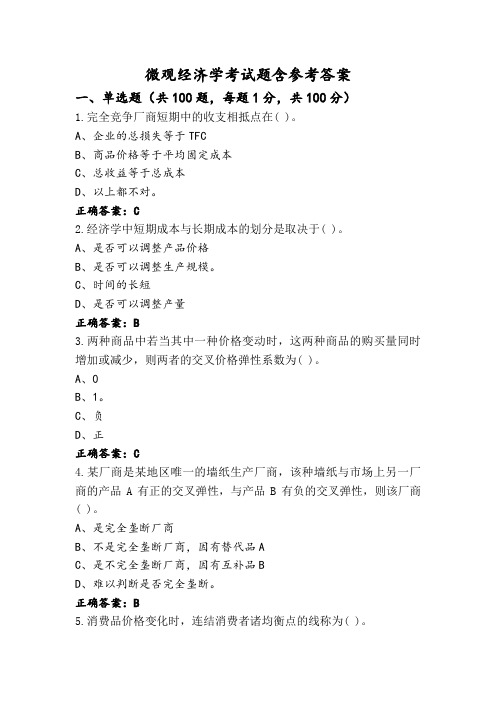
微观经济学考试题含参考答案一、单选题(共100题,每题1分,共100分)1.完全竞争厂商短期中的收支相抵点在( )。
A、企业的总损失等于TFCB、商品价格等于平均固定成本C、总收益等于总成本D、以上都不对。
正确答案:C2.经济学中短期成本与长期成本的划分是取决于( )。
A、是否可以调整产品价格B、是否可以调整生产规模。
C、时间的长短D、是否可以调整产量正确答案:B3.两种商品中若当其中一种价格变动时,这两种商品的购买量同时增加或减少,则两者的交叉价格弹性系数为( )。
A、0B、1。
C、负D、正正确答案:C4.某厂商是某地区唯一的墙纸生产厂商,该种墙纸与市场上另一厂商的产品A有正的交叉弹性,与产品B有负的交叉弹性,则该厂商( )。
A、是完全垄断厂商B、不是完全垄断厂商,因有替代品AC、是不完全垄断厂商,因有互补品BD、难以判断是否完全垄断。
正确答案:B5.消费品价格变化时,连结消费者诸均衡点的线称为( )。
A、恩格尔曲线。
B、需求曲线C、价格—消费曲线,D、收入—消费曲线正确答案:C6.正常物品价格上升导致需求量减少的原因在于( )。
A、替代效应使需求量增加,收入效应使需求量减少B、替代效应使需求量增加,收入效应使需求量增加C、替代效应使需求量减少,收入效应使需求量减少D、替代效应使需求量减少,收入效应使需求量增加。
正确答案:C答案解析:正常物品价格上升,会导致消费者购买力下降,从而减少需求量。
这是收入效应的表现。
同时,价格上升也会使得替代物品相对更具吸引力,从而增加替代效应,进一步减少需求量。
因此,选项C是正确的。
7.对完全垄断厂商来说( )。
A、提高价格一定能增加收益B、降低价格一定会减少收益C、提高价格未必能增加收益,降低价格未必能减少收益D、以上都不正确。
正确答案:C答案解析:对完全垄断厂商来说,其面临的市场需求曲线是其唯一的边际收益曲线。
因此,提高价格会导致销量下降,但每个单位的售价会增加,从而可能增加收益;降低价格会导致销量增加,但每个单位的售价会减少,从而可能减少收益。
微观经济学试题及答案

微观经济学试题及答案一、名词解释(每题3分,共12分)1. 需求曲线2. 边际效用3. 完全竞争市场4. 外部性5. 生产可能性边界二、选择题(每题2分,共10分)1. 在完全竞争市场中,厂商的利润最大化的条件是()A. P=AR=MRB. P=ARC. P=MRD. P=MC2. 以下哪个因素不属于影响供给的因素?()A. 技术水平B. 生产成本C. 消费者偏好D. 价格3. 某商品的需求价格为5元,供给价格为8元,如果政府对该商品实施价格干预,设定价格为6元,则会导致()A. 市场需求量增加,市场供给量减少B. 市场需求量减少,市场供给量增加C. 市场需求量增加,市场供给量不变D. 市场需求量减少,市场供给量不变4. 下列哪个市场结构中,企业数量最多?()A. 完全竞争市场B. 垄断市场C. 寡头垄断市场D. 完全垄断市场5. 某厂商生产两种产品,生产第一种产品的边际成本是4元,生产第二种产品的边际成本是6元。
如果厂商的目标是利润最大化,那么,厂商应该()A. 增加第一种产品的生产B. 增加第二种产品的生产C. 减少第一种产品的生产D. 减少第二种产品的生产三、简答题(每题5分,共20分)1. 请简述微观经济学研究的基本问题。
2. 请简述需求定理和供给定理。
3. 请简述完全竞争市场和完全垄断市场的特点。
4. 请简述外部性对经济的影响。
四、论述题(每题10分,共20分)1. 请论述价格弹性对厂商定价策略的影响。
2. 请论述微观经济学中市场竞争对资源配置的作用。
五、案例分析题(22分)某城市有两家公交公司A和B,它们在该城市公交市场上相互竞争。
A公司拥有30辆公交车,B公司拥有20辆公交车。
两家公司的公交车票价均为1元。
最近,A公司决定降低票价至0.8元,以吸引更多乘客。
假设其他条件不变,请分析以下问题:1. 请用微观经济学知识解释A公司降低票价的动机。
2. 请分析B公司可能的应对策略。
3. 假设降低票价后,A公司的乘客数量增加了20%,而B公司的乘客数量减少了10%。
微观经济学选择模拟考试题(含答案)
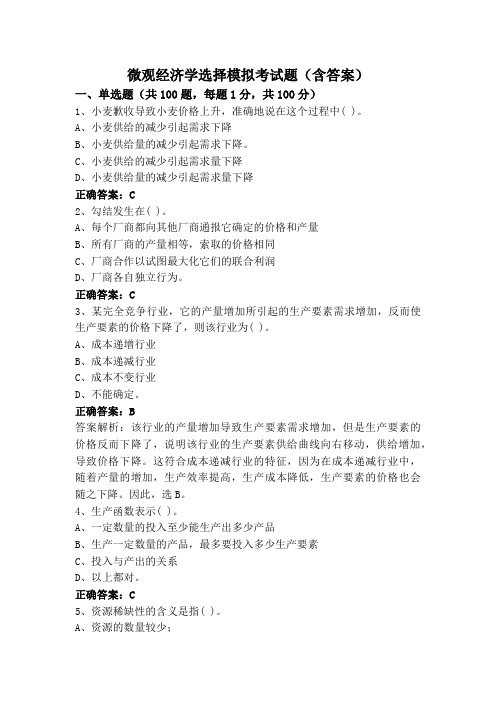
微观经济学选择模拟考试题(含答案)一、单选题(共100题,每题1分,共100分)1、小麦歉收导致小麦价格上升,准确地说在这个过程中( )。
A、小麦供给的减少引起需求下降B、小麦供给量的减少引起需求下降。
C、小麦供给的减少引起需求量下降D、小麦供给量的减少引起需求量下降正确答案:C2、勾结发生在( )。
A、每个厂商都向其他厂商通报它确定的价格和产量B、所有厂商的产量相等,索取的价格相同C、厂商合作以试图最大化它们的联合利润D、厂商各自独立行为。
正确答案:C3、某完全竞争行业,它的产量增加所引起的生产要素需求增加,反而使生产要素的价格下降了,则该行业为( )。
A、成本递增行业B、成本递减行业C、成本不变行业D、不能确定。
正确答案:B答案解析:该行业的产量增加导致生产要素需求增加,但是生产要素的价格反而下降了,说明该行业的生产要素供给曲线向右移动,供给增加,导致价格下降。
这符合成本递减行业的特征,因为在成本递减行业中,随着产量的增加,生产效率提高,生产成本降低,生产要素的价格也会随之下降。
因此,选B。
4、生产函数表示( )。
A、一定数量的投入至少能生产出多少产品B、生产一定数量的产品,最多要投入多少生产要素C、投入与产出的关系D、以上都对。
正确答案:C5、资源稀缺性的含义是指( )。
A、资源的数量较少;B、获得一定量资源所必须耗费的成本相当高;C、资源的价格很高。
D、相对于人类无限的欲望来说,再多的资源也显不足;正确答案:D6、若x和y两产品的交叉弹性是-2,则( )。
A、x和y是替代品B、x和y是正常商品C、x和y是互补品。
D、x和y是劣质品正确答案:C7、需求曲线斜率为正的充要条件是( )。
A、收入效应超过替代效应B、替代效应超过收入效应C、低档商品且收入效应超过替代效应。
D、低档商品正确答案:C8、当某消费者对商品X的消费达到饱和点时,则边际效用MUX为( )。
A、不确定,需视具体情况而定。
B、零C、负值D、正值正确答案:B9、垄断企业面对的需求函数为Q=100/ P2,企业的边际成本始终为1,垄断价格为( )。
微观经济学试题及参考答案大全
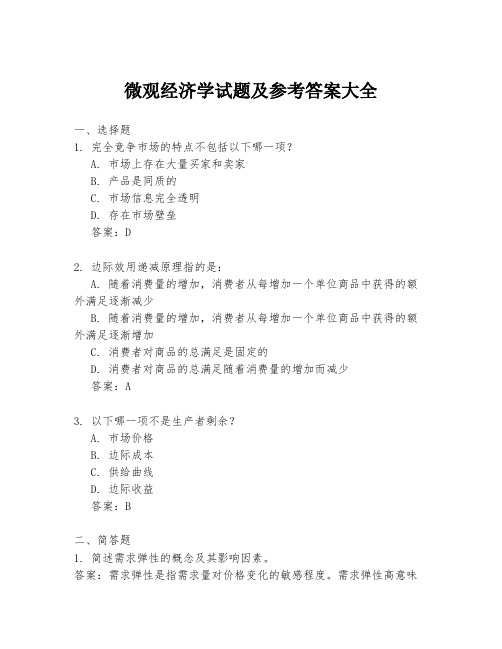
微观经济学试题及参考答案大全一、选择题1. 完全竞争市场的特点不包括以下哪一项?A. 市场上存在大量买家和卖家B. 产品是同质的C. 市场信息完全透明D. 存在市场壁垒答案:D2. 边际效用递减原理指的是:A. 随着消费量的增加,消费者从每增加一个单位商品中获得的额外满足逐渐减少B. 随着消费量的增加,消费者从每增加一个单位商品中获得的额外满足逐渐增加C. 消费者对商品的总满足是固定的D. 消费者对商品的总满足随着消费量的增加而减少答案:A3. 以下哪一项不是生产者剩余?A. 市场价格B. 边际成本C. 供给曲线D. 边际收益答案:B二、简答题1. 简述需求弹性的概念及其影响因素。
答案:需求弹性是指需求量对价格变化的敏感程度。
需求弹性高意味着价格的小幅变动会导致需求量的大幅变动。
影响需求弹性的因素包括商品的替代品数量、商品的必需品程度、消费者的收入水平、商品的用途多样性等。
2. 什么是边际成本和平均成本?它们之间的关系是什么?答案:边际成本是指生产额外一单位产品所增加的总成本。
平均成本是指生产单位产品的平均成本,等于总成本除以生产量。
边际成本与平均成本之间的关系是:当边际成本低于平均成本时,平均成本会下降;当边际成本高于平均成本时,平均成本会上升。
三、计算题1. 假设某公司生产函数为Q = 2L^(1/2)K^(1/3),其中Q是产量,L 是劳动投入,K是资本投入。
如果劳动投入L=4,资本投入K=27,求该公司的产量Q。
答案:将L=4和K=27代入生产函数Q = 2L^(1/2)K^(1/3),得到Q = 2 * (4)^(1/2) * (27)^(1/3) = 2 * 2 * 3 = 12。
2. 假设某商品的市场需求函数为Qd = 100 - 2P,供给函数为Qs = 5P。
求市场均衡价格和数量。
答案:市场均衡时,需求量等于供给量,即Qd = Qs。
将需求函数和供给函数相等,得到100 - 2P = 5P,解得P = 16。
微观经济学试题库含参考答案
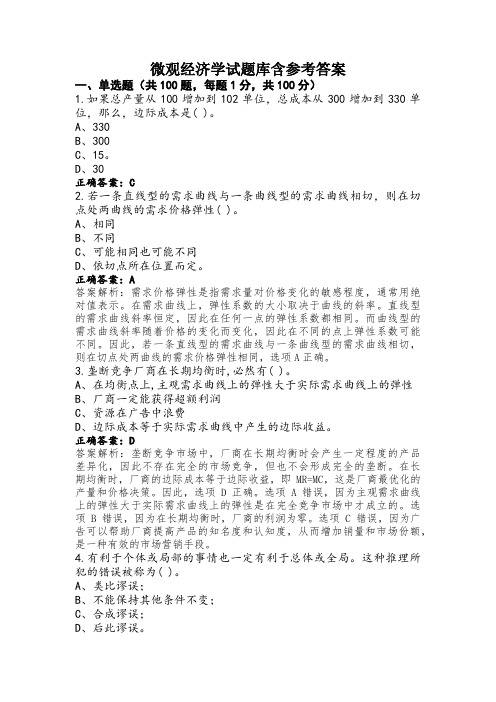
微观经济学试题库含参考答案一、单选题(共100题,每题1分,共100分)1.如果总产量从100增加到102单位,总成本从300增加到330单位,那么,边际成本是( )。
A、330B、300C、15。
D、30正确答案:C2.若一条直线型的需求曲线与一条曲线型的需求曲线相切,则在切点处两曲线的需求价格弹性( )。
A、相同B、不同C、可能相同也可能不同D、依切点所在位置而定。
正确答案:A答案解析:需求价格弹性是指需求量对价格变化的敏感程度,通常用绝对值表示。
在需求曲线上,弹性系数的大小取决于曲线的斜率。
直线型的需求曲线斜率恒定,因此在任何一点的弹性系数都相同。
而曲线型的需求曲线斜率随着价格的变化而变化,因此在不同的点上弹性系数可能不同。
因此,若一条直线型的需求曲线与一条曲线型的需求曲线相切,则在切点处两曲线的需求价格弹性相同,选项A正确。
3.垄断竞争厂商在长期均衡时,必然有( )。
A、在均衡点上,主观需求曲线上的弹性大于实际需求曲线上的弹性B、厂商一定能获得超额利润C、资源在广告中浪费D、边际成本等于实际需求曲线中产生的边际收益。
正确答案:D答案解析:垄断竞争市场中,厂商在长期均衡时会产生一定程度的产品差异化,因此不存在完全的市场竞争,但也不会形成完全的垄断。
在长期均衡时,厂商的边际成本等于边际收益,即MR=MC,这是厂商最优化的产量和价格决策。
因此,选项D正确。
选项A错误,因为主观需求曲线上的弹性大于实际需求曲线上的弹性是在完全竞争市场中才成立的。
选项B错误,因为在长期均衡时,厂商的利润为零。
选项C错误,因为广告可以帮助厂商提高产品的知名度和认知度,从而增加销量和市场份额,是一种有效的市场营销手段。
4.有利于个体或局部的事情也一定有利于总体或全局。
这种推理所犯的错误被称为( )。
A、类比谬误;B、不能保持其他条件不变;C、合成谬误;D、后此谬误。
5.会计利润等于总收益减( )。
A、显性成本B、边际成本。
微观经济学试题及答案
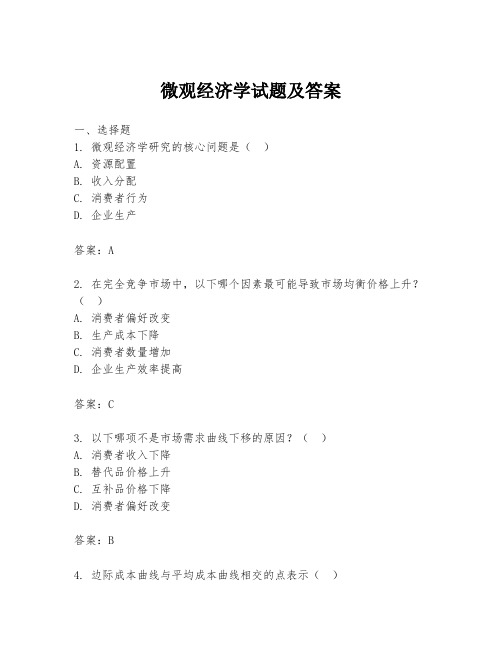
微观经济学试题及答案一、选择题1. 微观经济学研究的核心问题是()A. 资源配置B. 收入分配C. 消费者行为D. 企业生产答案:A2. 在完全竞争市场中,以下哪个因素最可能导致市场均衡价格上升?()A. 消费者偏好改变B. 生产成本下降C. 消费者数量增加D. 企业生产效率提高答案:C3. 以下哪项不是市场需求曲线下移的原因?()A. 消费者收入下降B. 替代品价格上升C. 互补品价格下降D. 消费者偏好改变答案:B4. 边际成本曲线与平均成本曲线相交的点表示()A. 企业亏损B. 企业盈利C. 企业生产最小化D. 企业生产最大化答案:B5. 如果一家公司的边际收益递减,那么()A. 总收益递增但增速放缓B. 总收益递减C. 边际成本递增D. 平均成本递减答案:A二、填空题1. 在微观经济学中,________是指在其他条件不变的情况下,一种商品价格变动所引起的该商品需求量变动的百分比与价格变动的百分比之比。
答案:价格弹性2. 当_________存在时,企业可以通过增加产量来降低单位成本。
答案:规模经济3. 在市场经济中,_________是指消费者愿意并且能够购买的商品或服务的数量。
答案:需求4. 微观经济学中的_________理论解释了企业如何决定生产多少商品以及如何定价。
答案:利润最大化5. 当市场上只有一个买家和多个卖家时,这种市场结构被称为_________。
答案:单买寡卖三、简答题1. 简述需求定律的内容及其在市场经济中的作用。
答案:需求定律指出,在其他条件不变的情况下,商品的价格与其需求量成反比,即价格上升时需求量下降,价格下降时需求量上升。
这一定律在市场经济中的作用主要体现在帮助生产者和消费者做出决策,如调整生产量和定价策略,以及预测市场变化等。
2. 描述边际成本与平均成本之间的关系。
答案:边际成本是指生产额外一单位产品所增加的成本,而平均成本是指单位产品的平均成本。
在生产过程中,随着产量的增加,边际成本会先降低后上升,这是因为规模经济效应使得单位成本降低,但当超过某一点后,由于拥挤效应等因素,单位成本会上升。
微观经济学考试和答案

微观经济学考试和答案一、单项选择题(每题2分,共20分)1. 需求曲线向左下方倾斜的原因是()。
A. 价格与需求量呈正相关B. 价格与需求量呈负相关C. 价格与需求量无关D. 价格与需求量呈非线性关系答案:B2. 边际效用递减规律表明,随着消费量的增加,边际效用()。
A. 增加B. 减少C. 不变D. 先增加后减少答案:B3. 在完全竞争市场中,企业是()。
A. 价格接受者B. 价格制定者C. 价格领导者D. 价格追随者答案:A4. 短期平均成本曲线呈U形的原因是()。
A. 规模经济B. 规模不经济C. 边际成本递减D. 边际成本递增答案:D5. 如果两种商品是互补品,那么一种商品价格上升,另一种商品的需求量会()。
A. 增加B. 减少C. 不变D. 先增加后减少答案:B6. 完全垄断市场中,企业面临的需求曲线是()。
A. 完全弹性B. 完全无弹性C. 向下倾斜D. 垂直答案:C7. 洛伦兹曲线是衡量()的图形。
A. 收入分配的公平程度B. 收入分配的不平等程度C. 收入分配的效率D. 收入分配的稳定性答案:A8. 公共物品的特点是()。
A. 非竞争性和非排他性B. 竞争性和排他性C. 竞争性和非排他性D. 非竞争性和排他性答案:A9. 价格弹性的计算公式是()。
A. 需求量变化的百分比 / 价格变化的百分比B. 价格变化的百分比 / 需求量变化的百分比C. 需求量变化的百分比 / 收入变化的百分比D. 收入变化的百分比 / 需求量变化的百分比答案:A10. 吉芬商品是一种()。
A. 低档商品B. 高档商品C. 正常商品D. 劣质商品答案:A二、多项选择题(每题3分,共15分)11. 以下哪些因素会影响需求曲线的位置()。
A. 消费者偏好B. 消费者收入C. 相关商品的价格D. 生产成本答案:ABC12. 以下哪些是完全竞争市场的特征()。
A. 企业数量众多B. 产品同质化C. 企业可以自由进出市场D. 企业是价格接受者答案:ABCD13. 以下哪些是影响供给曲线位置的因素()。
微观经济学考试题+参考答案

微观经济学考试题+参考答案一、单选题(共100题,每题1分,共100分)1.某完全竞争厂商的销售量Q=10,单价P=8,其总变动成本为60,则生产者剩余为( )。
A、20B、140。
C、60D、80正确答案:A2.边际成本低于平均成本时,( )。
A、平均成本上升B、平均可变成本可能上升也可能上升也可能下降C、总成本下降D、平均可变成本上升。
正确答案:B答案解析:当边际成本低于平均成本时,说明新增生产的单位成本低于平均成本,这可能是因为新增生产的单位产量较少,而固定成本已经分摊到之前的产量中,因此平均成本会上升。
但是,新增生产的单位成本低于平均成本,说明新增生产的单位可变成本也低于平均可变成本,因此平均可变成本可能上升也可能下降。
总成本下降的情况不太可能出现,因为新增生产的单位成本低于平均成本,但是总成本仍然包括之前的固定成本,因此总成本不太可能下降。
因此,选项B是正确的。
3.经济学中短期成本与长期成本的划分是取决于( )。
A、时间的长短B、是否可以调整生产规模。
C、是否可以调整产品价格D、是否可以调整产量正确答案:B4.某消费者消费A、B两种商品,假定消费者的收入增加了一倍,同时两种商品的价格也提高了一倍,该消费者的预算线将( )。
A、向外平移但斜率不变B、向外移动但更陡峭C、向外移动但更平缓D、不变。
正确答案:D5.已知消费者的收入是lOO元,商品X的价格是10元,商品Y的价格是3元。
假定他打算购买7单位X和10单位Y,这时商品X和Y的边际效用分别是50和18。
如要获得最大效用,他应该( )。
A、同时增购X和Y。
B、增购X、减少Y的购买量C、停止购买D、减少X的购买量,增购Y正确答案:D6.垄断企业面对的需求函数为Q=100/ P2,企业的边际成本始终为1,垄断价格为( )。
A、1B、2C、5D、10。
正确答案:B答案解析:垄断企业的利润最大化条件为边际收益等于边际成本。
由需求函数可得,总收益为PQ=100/P。
微观经济学题库及答案
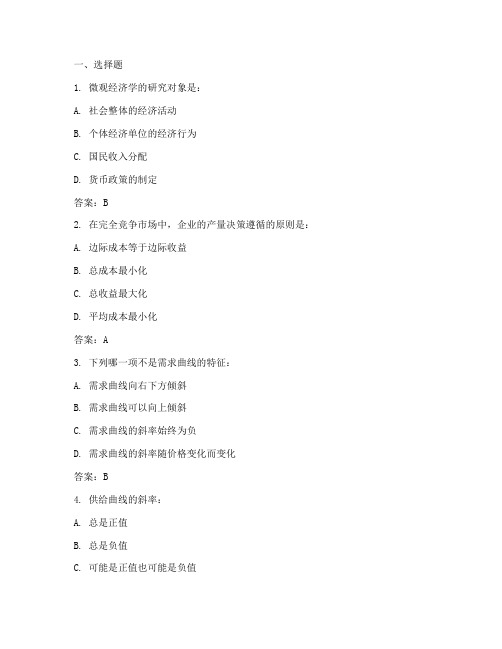
一、选择题1. 微观经济学的研究对象是:A. 社会整体的经济活动B. 个体经济单位的经济行为C. 国民收入分配D. 货币政策的制定答案:B2. 在完全竞争市场中,企业的产量决策遵循的原则是:A. 边际成本等于边际收益B. 总成本最小化C. 总收益最大化D. 平均成本最小化答案:A3. 下列哪一项不是需求曲线的特征:A. 需求曲线向右下方倾斜B. 需求曲线可以向上倾斜C. 需求曲线的斜率始终为负D. 需求曲线的斜率随价格变化而变化答案:B4. 供给曲线的斜率:A. 总是正值B. 总是负值C. 可能是正值也可能是负值D. 随价格变化而变化答案:A5. 效用理论中,消费者在消费过程中追求的是:A. 总效用最大化B. 边际效用最大化C. 总成本最小化D. 边际成本最小化答案:B6. 市场失灵的原因不包括:A. 信息不对称B. 外部性C. 公共物品D. 市场竞争充分答案:D7. 下列哪一项不是博弈论的研究内容:A. 竞争策略B. 合作策略C. 市场需求D. 供给曲线答案:C8. 在完全垄断市场中,企业的边际收益曲线:A. 与需求曲线重合B. 位于需求曲线之上C. 位于需求曲线之下D. 与需求曲线平行答案:C9. 微观经济学中的“无差异曲线”是指:A. 表示消费者偏好的曲线B. 表示生产者成本曲线C. 表示供求均衡曲线D. 表示市场均衡曲线答案:A10. 下列哪一项不是市场效率的表现:A. 资源配置效率B. 产品质量最优C. 市场价格最低D. 信息透明度最高答案:B二、简答题1. 简述微观经济学的研究方法。
答案:微观经济学的研究方法主要包括:(1)边际分析法:通过分析经济变量边际变化对总量的影响,揭示经济现象的规律。
(2)供求分析法:通过分析市场供求关系的变化,研究价格、产量等经济变量的决定。
(3)比较分析法:通过比较不同市场、不同经济主体之间的差异,揭示经济现象的内在联系。
(4)实证分析法:通过收集、整理和分析实际经济数据,验证经济学理论。
微观经济学试题及答案

微观经济学一、单项选择题1. 研究家庭和企业决策的经济学称为()。
A.宏观经济学 B.微观经济学C.实证经济学 D.规范经济学2. 社会经济资源的基本特征是()。
A.经济性 B.有用性C.无限性 D.稀缺性3. 下列问题不属于宏观经济学的是()。
A.货币量变动对通货膨胀的影响 B.企业关于雇用多少工人的决策C.高储蓄对经济增长的影响 D.政府管制对汽车废气的影响4. 当胶卷的价格上升时,照相机的需求量将会()。
A.增加B.减少C.不变D.变化不定5. 以下引起需求变动的因素是()。
A.生产要素价格 B. 生产能力水平B.人们的消费偏好 D. 商品价格水平6. 当茶叶的价格上升时,咖啡的需求量将会()。
A. 增加B. 减少C.不变D.变化不定7. 边际效用是指()。
A. 增加单位商品的消费而增加的平均效用量B. 增加单位商品的消费而增加的总效用量C. 增加单位商品的消费而减少的平均效用量D. 增加单位商品的消费而减少的总效用量8. 一般来说,当消费者沿着同一条无差异曲线增加X物品(用横线代表)的消费量()。
A.每增加1单位X物品就要放弃更多的Y物品B.每增加1单位X物品就要放弃更少的Y物品C.边际替代率递减D.b与c都对9. 第四张比萨饼带来的满足不如第三张比萨饼这一事实是下列哪一个概念的例子。
()A. 消费者剩余B. 总效用递减C. 边际效用递减D. 价值之谜10. 边际报酬递减规律研究的问题是()。
A. 各种生产要素同时变动对产量的影响B. 不同生产要素变动对产量的影响C. 特殊生产要素变动对产量的影响D. 其他生产要素不变,一种生产要素变动对产量的影响11. 在其他生产要素不变的条件下,平均产量曲线与边际产量曲线的交点代表()。
A.总产量达到最大 B. 要素产出效率最高C. 边际产量为零D. 边际产量达到最大12. 劳动对资本的边际替代率衡量()。
A.在保持产量不变时,劳动量增加1单位资本量增加多少B.在保持产量不变时,劳动量增加1单位资本量减少多少C.相对于资本价格的劳动价格D.等成本线的斜率13. 已知产量为100单位时间,总成本为9500元,当产量增加到110单位时,总成本为10000元。
微观经济学题库及答案
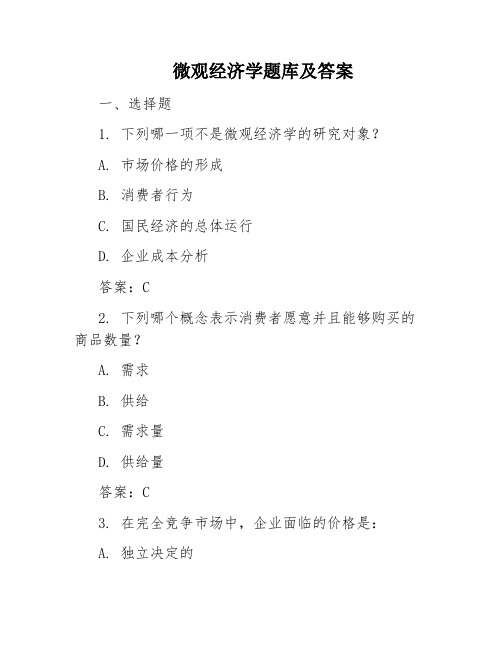
微观经济学题库及答案一、选择题1. 下列哪一项不是微观经济学的研究对象?A. 市场价格的形成B. 消费者行为C. 国民经济的总体运行D. 企业成本分析答案:C2. 下列哪个概念表示消费者愿意并且能够购买的商品数量?A. 需求B. 供给C. 需求量D. 供给量答案:C3. 在完全竞争市场中,企业面临的价格是:A. 独立决定的B. 由企业自己设定的C. 由市场决定的D. 由政府规定的答案:C4. 下列哪一项不是导致需求曲线向右移动的因素?A. 消费者收入增加B. 相对价格下降C. 产品价格上升D. 消费者偏好改变答案:C5. 下列哪一项不是供给曲线向左移动的因素?A. 生产成本上升B. 技术进步C. 生产者预期价格上升D. 政府对行业的限制答案:B二、填空题1. 微观经济学的研究方法主要是______和______。
答案:实证分析、规范分析2. 在经济学中,消费者剩余是指消费者愿意支付的价格与______之间的差额。
答案:实际支付的价格3. 市场均衡时,供给等于______。
答案:需求4. 在完全竞争市场中,企业是______。
答案:价格接受者5. 资源配置最优化发生在______。
答案:市场均衡时三、简答题1. 简述需求曲线的形状及其影响因素。
答案:需求曲线通常向下倾斜,表示价格与需求量呈负相关。
需求曲线的形状和斜率受到多种因素的影响,包括消费者的收入、替代品和互补品的价格、消费者偏好等。
2. 解释价格机制在资源配置中的作用。
答案:价格机制通过反映供求关系来引导资源的分配。
当价格上升时,生产者会增加生产,消费者会减少消费,从而实现资源从需求较少的领域转移到需求较多的领域。
3. 简述市场失灵的几种常见类型。
答案:市场失灵的类型包括公共物品、外部性、不完全竞争和信息不对称等。
公共物品无法通过市场机制有效提供,外部性导致市场无法反映社会成本和收益,不完全竞争导致市场效率低下,信息不对称导致市场参与者无法做出最优决策。
微观经济学考试题库及答案详解
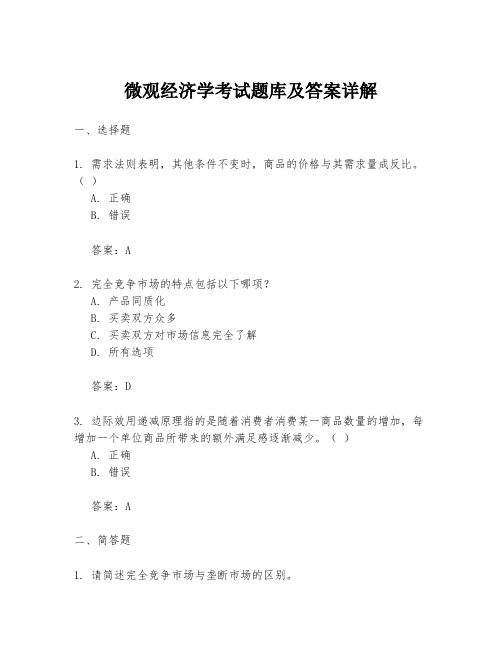
微观经济学考试题库及答案详解一、选择题1. 需求法则表明,其他条件不变时,商品的价格与其需求量成反比。
()A. 正确B. 错误答案:A2. 完全竞争市场的特点包括以下哪项?A. 产品同质化B. 买卖双方众多C. 买卖双方对市场信息完全了解D. 所有选项答案:D3. 边际效用递减原理指的是随着消费者消费某一商品数量的增加,每增加一个单位商品所带来的额外满足感逐渐减少。
()A. 正确B. 错误答案:A二、简答题1. 请简述完全竞争市场与垄断市场的区别。
答案:完全竞争市场与垄断市场的主要区别包括:- 完全竞争市场存在众多买家和卖家,没有单个买家或卖家能够影响市场价格;而垄断市场中,一个卖家控制整个市场,能够影响价格。
- 完全竞争市场中的产品是同质的,没有品牌差异;垄断市场中的产品可能是独特的,具有品牌差异。
- 完全竞争市场中进入和退出市场没有障碍;垄断市场中存在进入障碍,新企业难以进入。
2. 什么是价格弹性?请举例说明。
答案:价格弹性是指需求量或供给量对价格变化的敏感度,用公式表示为:弹性 = (需求量的百分比变化 / 价格的百分比变化)。
例如,如果某种商品的价格上升10%导致需求量下降20%,那么该商品的需求价格弹性为-2,表示为弹性大于1,是弹性较大的商品。
三、计算题1. 假设某商品的需求函数为 \( Q_d = 100 - 5P \),供给函数为\( Q_s = 2P \)。
求市场均衡价格和数量。
答案:市场均衡时,需求量等于供给量,即 \( Q_d = Q_s \)。
\( 100 - 5P = 2P \)\( 100 = 7P \)\( P = 100 / 7 \)将价格 \( P \) 代入需求或供给函数求得数量 \( Q \):\( Q = 2 \times (100 / 7) = 200 / 7 \)四、论述题1. 论述市场失灵的原因及其可能的解决措施。
答案:市场失灵是指市场机制不能有效分配资源的情况。
- 1、下载文档前请自行甄别文档内容的完整性,平台不提供额外的编辑、内容补充、找答案等附加服务。
- 2、"仅部分预览"的文档,不可在线预览部分如存在完整性等问题,可反馈申请退款(可完整预览的文档不适用该条件!)。
- 3、如文档侵犯您的权益,请联系客服反馈,我们会尽快为您处理(人工客服工作时间:9:00-18:30)。
1. The scie ntific method is not applicable to the study of economics becauseeconomics is not a true scie nee.A) TrueB) False2. Hypotheses derived from econo mic an alysis can be validated throughempirical an alysis, but hardly ever with absolute certai nty.A) TrueB) False3. Which of the follow ing stateme nts relates to the con cept of efficie ncy?A) The abse nee of waste.B) Using resources as effectively as possible.C) Being able to produce more of one good only by producing someth ing else.D) All the above.E) b. and c. only.4. Figure 1 displays the product ion-possibilities of two coun tries.that both countries produce five units of x, which of the following best describes countryB's producti on of y?A) Less tha n country A's product ion of y.B) The same as country A's producti on of y.C) More tha n country A's producti on of y.D) Cannot be determ ined from the graph.E) None of the above.5. Mass unemployment of resources means society operatesproduct ion-possibility fron tier .A) TrueB) Falseless ofGive nin side its Figure 16. If two goods use the same resources and the same tech no logy, product ion possibilities curve betwee n the two goods will have a positive slope.A) TrueB) False7. It is scarcity that makes goods econo mic goods.A) TrueB) False8. Which of the follow ing is the most basic of the subjects with which the study of economics must try to deal?A) Markets.B) Mo ney.C) Profit seeki ng.D) The price mecha ni sm.E) Scarcity.9. Poor money man ageme nt by the gover nment, aside from in creas ing the un employment rate, will have a relatively small effect on the economy.A) TrueB) False11. Barter is inconvenient because:A) barga ining power is un equal betwee n rich and poorB) without mon ey, who can defi ne "fair" values?C) my wants and supplies do not match your supplies and wan ts.D) it leads to imperfect competiti on.theFigure 210. In Figure 2, what is Country B's cost of produci ng 1 un it of x in termsof y?A) 10 units of y.B) 1/2 units of y.C) 5 units of y.D) 2 units of y.E) None of the above.E) all of the above.12. The econo mic role of gover nment in mixed econo mies can in clude:A) provisi on of public goods.B) tax collect ions.C) in come redistributi on.D) all of the above.E) none of the above.13. By the "in visible han d," Smith meant the in flue nee and lobby ing of the hidde n in terest groups.A) TrueB) False14. A society which forgoes prese nt con sumpti on:A) is forced to do so because of excessive con sumpti on with in the country in the past.B) may be devot ing new resources to new capital formatio n.C) is merely devot ing resources to the replaceme nt of capital.D) expects to con sume only that amount tomorrow which was forego ne today.E) does none of the above.15. An econo mic good is valued in part by its scarcity.A) TrueB) False16. The stateme nt that roun dabout methods of producti on are often more efficie nt tha n more direct methods:A) means that roun dabout methods use the same in puts as more direct methods, except for time, which is not a scarce economic good.B) means that con sumers ought to choose those goods which most lend themselves to roun dabout methods of product ion.C) means that the most roun dabout method is always the most efficie nt method of produci ng any output.D) is false, for direct and in direct methods of product ion are usually the same in terms of efficie ncy.E) suggests that forego ne con sumpti on devoted to in vestme nt sometimes in creases future output in ways that more closely match in dividual an d/or social desires.17. Which of the following statements is true of specialization?A) Specializati on is incon siste nt with the idea of in dividual freedom.B) Econo mies that practice a divisi on of labor are morally superior to those that do not.A) True B) False22. An in crease in price will lead to a lower qua ntity dema nded because:A) suppliers will supply only the smaller amount. B) quality deteriorates.C) people will purchase less of the good. D) all of the above.E) none of the above.Use the following to answer question 23:C) In accepting specialization, a person sacrifices his or her own interests for the sake of society's in terest.D) While specializati on has eno rmous adva ntages, the coststhem.E) In creased productivity is more likely to be achievedspecializati on.18. In an afflue nt moder n society, bus in esses may have to offer workers more fulfilli ng jobs.A) True B) False19. Con sumers vote their dollars primarily in: A) labor markets. B)land markets. C) capital markets. D) goods markets . E)none of the above.20. An example of legal limitations on property rights is the prohibition of polluti on.A) True B)False21. Lower prices coax out higher qua ntities dema ndeddow nward-slop ing dema nd outweigh through25. Upward-slop ing supply curves are the result of: A) in creas ing retur ns to scale. B) in creas ing costs of product ion. C) cha nges in gover nment policies. D) cha nges in tech no logy. E) none of the above23.Let P* and Q* represe nt market cleari ng price and qua ntity, respectively. Given the supply and dema nd curves draw n in Figure 3, a reduct ion in the price of an in put used in the product ion of Q can be expected to cause:A) P* and Q* to climb.B)P* to climb while Q* falls.C) P* to climb while Q* holds steady D) P* to fall while Q* climbs. E) P* and Q* to fall.Use the following to answer question 24:Table 1The Market for Potato Chips(qua ntities measured in bags per week)Price Quan titySupplied $1.00 500 20002.00 1000 17503.0015001500 4.00 2000 1250 5.00 25001000Quan tity Dema nded 24. Accordi ng to T A) $1.00. B)$2.00. C) $2.50. D) $3.00.able 1, the equilibrium price for potato chips is:Quantity of QFigure 3E) $4.00.26. To say that a price "clears the market" is to say that every one who wants that commodity is getting all they want.A) TrueB) False27. The positi on of the supply schedule for America n-made cars will not be directly affected by which of the follow ing?A) Union wage rates.B) Car prices.C) The possibility of strikes.D) A cha nge in assembly tech no logy.E) All of the above will affect supply.28. The dema nd curve for a no rmal good will shift to the right if:A) in come in creases.B) populati on in creases.C) the price of a substitute good in creases.D) all the above.E) none of the above.29. Give n a fixed supply of lamb chops, a reduct ion in the price of pork chops (close substitutes) will tend to: (这类题比容易出)A) shift the dema nd curve for lamb chops to the right.B) shift the dema nd curve for pork chops to the right.C) shift the dema nd curve for pork chops to the left.D) raise the price of lamb chops.E) lower the price of lamb chops.30. One reas on that supply curves display positive slope is that:A) expa nded product ion may require the use of superior resources.B) people are not willi ng to pay a higher price for more goods.C) expa nded in dustry output might cause a labor shortage andsubseque ntly in crease the wage rate in cluded in the cost of product ion.D) extra producti on brings in the more efficie nt, lower-cost producers.E) the law of diminishing retur ns is importa nt to producers.31. If a 1 percent change in price causes a 5 percent change in quantity dema nded, the n dema nd is price in elastic.A) TrueB) False32. Whe never total expe nditure (i.e., total revenue) remai ns the same aftera cha nge in price, the elasticity of dema nd is:A)greater tha n 1.B) less tha n 1. C) equal to 0. D) equal to 1. E) equal to infinity33. If price and quantity sold both decrease from one period to another may infer that the law of dow nward-slop ing dema nd does not operate in that market.A) True B) False(重要) 34. In "tight" hous ing markets, rent con trols are ofte n applied tohold the price of hous ing to a "reas on able" level. What is the immediate effectof this price policy with respect to the allocative fun cti ons of prices, and the relative in comesof tenants and Ian dlords?A) The allocative function of prices is impaired, but the tenants preve nted from gaining at the expe nse of the Ian dlords.B) The allocative function of prices is not impaired, and the tenants are preve nted from gaining at the expe nse of Ian dlords.C) The allocative function of prices is impaired, and the tenants who find hous ing gain at the expe nse of Ian dlords.D) The allocative function of prices is not impaired, but the Iandlords gain at the expe nse of tenants who do not find hous ing.E) None of the above.35. Which of the following inefficiencies might be the result of monopoly power's destro ying a competitive equilibrium?A) Prices too high. B) Output too low.C) Wages distorted across the economy. D) In put prices distorted across the economy. E) All of the above.36. Dollar receipts for sellers of some commodities will be lower at higher prices. A) True B) False37. The qua ntity of a good which a pers on will purchase will not depe nd on which one of the following items? xA) The price of the good. B) His or her tastes.C) The prices of substitute goods. D) His or her in come. E) The elasticity of supply.,weareUse the following to answer question 38:Price20 40 60 SQ 100 120 QuErntliyFigure 438. Refer to Figure 4 once aga in. Suppose that now the dema nd curve has shifted to D'D'. At what poi nt alo ng D'D' is price elasticity equal to 1?A) GB) between G and H.C) H.D) between H and I.E) I.39. Rank the supply curves in the figure below in order of greatest to least price elasticity at the com mon in tersect ion point.A) C, A, B.B) B, A, C.C) B, C, A.D) A, B, C.E) None of the above.40. A price subsidy of 20 cents per gall on on milk (which does not have a totally in elastic dema nd curve) will result in a:A) cha nge in con sumer tastes.B) drop in the equilibrium price of 20 cents per gall on.C) drop in the equilibrium price of less tha n 20 cents per gall on.D) drop in the equilibrium price of more tha n 20 cents per gall on.41. The law of diminishing marginal utility states that the:A) ratio of MU to P for luxuries is lower than that for necessities.B) utility derived from the last unit of the good consumed falls as the con sumpti on of the good in creases.C) ratio of MU to P will be the same for all goods.D) utility derived from total con sumpti on of a good falls as con sumpti onin creases.E) none of the above.42. A consumer is said to be in equilibrium in his or her choice between twogoods A and B whe n:A) the purchase of good A gives the same satisfacti on as the purchase of good B.B) the last purchase of good A gives the same additi on to satisfact ion asthe last purchase of good B.C) each penny spe nt on good A gives the same satisfact ion as each pennyspe nt on good B.D) the last penny spent on good A gives the same addition to satisfactionas the last penny spe nt on good B.E) the last pennies spe nt on goods A and B gen erate no additi ons to satisfact ion.43. A con sumer spe nds all of her in come on two goods, coffee anddough nu ts. She purchases coffee at 25 cents a unit with a total utility of 800and a marginal utility of 12. Dough nuts are purchase at 75 cents a unit with atotal utility of 200 and a marginal utility of 24. In order to reach con sumer equilibrium, she should con sume:A) less dough nuts and more coffee.B) more dough nuts but the same amount of coffee.C) more coffee but the same amount of dough nu ts.D) more dough nuts and less coffee.E) the same amount of coffee and dough nu ts.44. If a pers on only con sumes pickles and pea nut butter , he will con sume pea nut butter up to the point where the:A) marginal utility of the last un it of pea nut butter con sumed equals that of the last unit of pickles con sumed.B) total utility of pea nut butter con sumed equals the total utility of picklescon sumed.C) con sumer surplus of pea nut butter con sumpti on equals the con sumer surplus of pickle con sumpti on.D) last dollar spe nt on pea nut butter con sumpti onprovides the same marginal utility as the last dollar spe nt on pickle con sumpti on.E) none of the above.45. Water tends to have a low marginal utility because substitutes for it are widely available.A) TrueB) False46. A good which sells for a higher price tha n one which is more importa nt for welfare reflects the con cept of:A) compleme ntarity in dema nd.B) substituti on.C) marginal or total utility.D) the paradox of value.E) law of diminishing marginal utility.47. The price of good X is $1.50 and that of good Y, $1. A particularconsumer who evaluates the marginal utility of Y to be 30 units, and is in equilibrium with respect to purchases of X and Y , must con sider the marginalutility of X to be:A) 15 un its.B) 20 un its.C) 30 un its.D) 45 un its.E) none of the above.48. It is possible to sum in dividual dema nd curves to get the marketdema nd curve on ly whe n all con sumers are exactly alike in their dema nds.A) TrueB) False49. The paradox of value is not the result of decli ning marginal utility.A) TrueB) False50. In the figure below, which area represents consumer surplus at a price of 5?A) OADC.B) OBEC. C) CEH. D) OBEH. E) CEGF.51. Both in nu mber and in dollar value of sales, the in dividual proprietorship is the dominantform of America n en terprise.A) True B) False52. Suppose that two in puts, K and L, are variable and in crease at the samerate . Which one of the pan els in Figure 5 represe nts In creas ing Retur n to Scale (IRS)?A) Panel a. B) Pa nel b. C) Pa nel c. D) Pa nel d.E)None of the above.53. " Un limited liability" in partn erships refers to the liability of each part ner for her perce ntage share of any losses in curred, without limit, except for some legal minimum of property she isLabor(L)Use the following to answer question 52:Figure 5permitted to keep.A) TrueB) False54. The employme nt of which of the follow ing in puts might be adjusted in the short run?A) Physical capital.B) Number of hours worked by laborC) Un its of en ergy required per un it output.D) Un its of material required per un it output.E) None of the above.55. Numerically, the bulk of bus in esses in the U.S. are:A) corporati ons.B) part nerships.C) sole proprietorships.D) farms.E) mom-a nd-pop retail shops.56. If in comes were properly distributed, competitive gen eral equilibrium would move resources to the best use for con sumers' satisfact ion.A) TrueB) FalseUse the follow ing to an swer questi ons 57:Total Product withVarious In put Comb in atio nsLabor Land 10 15 200 0 0 01 20 20.67 20.52 38 39.33 40.03 54 57.00 58.54 68 72.67 76.05 80 87.33 92.56 90 102.00 108.057. Suppose that producti on were defi ned by the fun cti on recorded in thetable above. For diminishing returns to continue to hold for the 7th unit of labor with land equal to 15 un its, total product for the comb in ati on of [labor =7;land = 15] would have to be less tha n:A) 0.B) 116.67. C) 115.67. D) 114.67.E) none of the above.Use the followi ng to an swer questi ons 58-59:Table 2Total Product withVarious In put Comb in atio ns Land Labor 10 15 200 00 01 20 20.67 20.52 38 39.33 40.0 3 54 57.00 58.5 4 68 72.67 76.0 5 80 87.3392.5690 102.00 108.058. The product ion processdefi ned by the function recordeddisplays diminishing retur ns in both labor and land.A) True B) False59. The product ion process defi ned by the function recordeddisplays decreas ing retur ns to scale for labor but not for land.A) True B) False60. Which of the followi ng is an example of a project that could be observed in the short run? A) The con structi on of a new assembly line to match an existi ng one.B) The con structi on of a new assembly line to take adva ntage of a new tech no logy. C) The moving of an established assembly line to bring it geographically closer to a market. D) The sale of an existing assembly line on the scrap market to finance part of a new facility. E) None of the above.61. Horizontal long-run MC is associated with constant returns to scale. A) True B) False62. A fixed cost is:in Table 2in Table 2A) the cost of any in put whose per-un it price has bee n fixed, whether by Ion g-term con tract or by some similar means.B) a cost whose in creases are exactly proporti onal to in creases in output.C) any comp onent in cluded in average cost which en ters in AC as the same fixed per-un it amount, no matter what the level of pla nt output may be.D) a cost which the firm would in cur even if its output were zero.E) none of the above.Use the followi ng to an swer questi ons 63-64:Table 3Qua ntity Variable Cost Total Cost1 25 402 45 603 60 754 70 855 85 1006 105 1 207 132 1 4763. What is MC between Q = 3 and Q = 4 in Table 3?A) 10B) 15C) 20D) 25E) None of the above.64. What is AFC at Q = 5 in T able 3?A) 3B) 4C) 5D) 7.5E) 1565. Total cost at q + 1 minus total cost at q gives marginal cost for the qth un it.A) True___ B) False66. The bala nee sheet always bala nces because:A) by defi niti on, profit is the residual betwee n revenue and cost.B) every proper official bus in ess stateme nt is audited by a firm in depe ndent acco untan ts.C) acco untan ts, like statisticia ns, know how to man ipulate the truth.D) by definition, net worth equals the differenee between assets liabilities.E) none of the above.of and67. A driver wishes to buy gasoli ne and have her car washed. She finds that the wash costs $3.00 when she buys 19 gallons at $1.00 each, but that ifshe buys 20 gallons, the car wash is free. Thus the marginal cost of thetwen tieth gallo n of gas is:A) -$2.00.B) $0.00.C) $1.00.D) $2.00.E) none of the above.68. If a firm produces more goods tha n it sells and buys more raw materialsthan it uses up duri ng the year ,an inven tory adjustme nt must be made so asnot to:A) overstate earnings for the year .B) un derstate earnings for the year .C) overstate liabilities at the end of the yearD) un derstate liabilitiesg at the end of the yearE) overstate assets at the end of the year69. Both the bala nee sheet and the in come stateme nt in dicate the flow of sales, cost, and revenue over the accounting period.A) TrueB) False70. In calculating a firm's total costs, which of the following is not included?A) The own er's expertise.B) The dema nd curve facing the firm.C) The taxes paid by the firm.D) Non-esse ntial costs, such as advertis ing and en terta inment expe nses.E) In put prices.71. The zero-profit point for a perfectly competitive firm occurs where the price equals the minimum point of the:A) AVC curve.B) AC curve.C) MC curve.D) AFC curve.E) none of the above.72. In the long run, all costs:A) lie along a perfectly elastic long-run supply curve.B) are fixed costs.C) are variable costs.D) exhibit con sta nt retur ns to scale.E) depe nd upon the dema nd structure of the give n market.73. Pure econo mic rent is the price paid to a factor of product ion that is fixed in total supplyA) TrueB) False74. If, in long run equilibrium, the competitive price of some good is $16.67, then, for each and every firm in the in dustry,A) marginal cost > average cost = $16.67.B) marginal cost < average cost = $16.67.C) $16.67 = marginal cost = average cost.D) $16.67 = marginal cost > average cost.E) $16.67 = marginal cost < average cost.75. A tax on the emission of a pollutant from the firms of a competitiveindustry can be expected to cause the equilibrium quantity demandedand supplied to decli ne.A) TrueB) False76. In a market economy, the short -run react ion to an excess supply of a commodity after a decrease in dema nd is:A) price will rise, but profits fall.B) price and profits will fall.C) price will fall, but profits will be un cha nged.D) price will fall, but profits will in crease.E) price and profits will both in crease.77. In the long run, any firm will eventually leave an industry if:A) price does not cover at least average total cost.B) price is not equal to marginal cost.C) price is higher tha n average variable cost.D) price is not at least equal to the minimum of the marginal cost curve.E) other firms in the in dustry are leav ing.Use the following to answer question 78:78. I n Figure 6, the firm's econo mic profits will equal: A) 0. B) $40. C) $100. D) $150.E) none of the above. 79. Which of the followi ngis in compatiblewith an efficie ntoptimum?A) Perfect competiti on. B) Abse nee of exter nalities. C) Mon opoly.D) All of the above are in compatible. E) None of the above is in compatible. 80. Un der con diti ons of decreas ing cost: A) exter nalities are irreleva nt and in applicable.B) each of the firms in the industry will continue to produce more output at falli ng costs per un it.C) a strong case can be made for suppla nti ng complete in dividualism by some kind of group action.D) a few large sellers may come to domin ate the in dustry. E) mon opolizati on of the in dustry becomes impossible. Use the follow ing to an swer questi ons 81-82:Table 4 P Q $5 8 $4 12 $3 17$2 22 $1 2781. Suppose an impefect competitor faces the dema nd curve defi ned inecono mic心QuanlityFigure 6Table 4, and its MC is con sta nt at $2.00. If the firm is able to produce at any output level, then it maximizes profits at:A) P= =5; q==8B) P= =4; q==12.C) P= =3; q==17.D) P= =2; q==22.E) none of the above if fixed costs are less tha n $1.00.82. Con sider the dema nd curve give n in Table 4. If the imperfectly competitive firm is able to produce at any output level, then the price and qua ntity which maximize total revenue are:A) P= =5; q==8B) P= =4; q==12.C) P= =3; q==17.D) P= =2; q==22.E) P= =1; q==27.83. Falli ng marginal revenue facing an in dividual firm is in compatible with:A) growth of the firm.B) perfect competiti on.C) oligopoly.D) barriers to en try.E) none of the above.(迷惑) 84. A perce ntage tax on a mono polist's profit has no effect on the profit-maximiz ing output as long as the tax is no greater tha n 100%.A) TrueB) False85. A profit-maximizing firm will always try to operate at the level of output at which its average costs are at a minimum, i.e., at the bottom of its U-shaped cost curve.A) TrueB) False86. Steel is an oligopolistic in dustry in the U.S.A) TrueB) False87. If all firms in an industry sell identical products, then it would never pay to advertise.A) TrueB) False88. The marginal cost schedule facing an imperfect competitor is con sta ntat $12. The dema nd curve is give n in Table 5. The profit maximiz ing outputfor this firm is:Table 5P Q$20 6$19 7$18 8$17 9$16 l0A) 6 unitsB) 7 unitsC) 8 unitsD) 9 unitsE) 10 units89. If a firm's dema nd curve is horiz on tal, the n the firm's marginal revenue is:A) less tha n the price of the product.B) equal to the price of the product.C) greater tha n the price of the product.D) greater tha n, equal to, or less tha n the price of the product, depe nding on the particular circumsta nces.E) not determ in able from the above in formati on.90. An imperfect competitor is not willi ng to in crease sales at the prevaili ng price because to do so would reduce marginal revenue. (价格不能保持)A) TrueB) False91. If price equals P1 for a monopolist good and P2 for a competitive good, the n for any si ngle con sumer the ratio of marginal utilities, MU1/MU2: (等边际)A) is exactly 1, and equal to the ratios of marginal costs, MC1/MC2.B) is exactly 1, and less than the ratios of margi nal costs, MC1/MC2.C) is exactly 1, and greater than the ratios of margi nal costs, MC1/MC2.D) is exactly 1, and MC1 = MC2E) cannot be determ ined on data give n.Use the following to answer questions 92-93:92. By the deadweight loss due to mono poly, we mea n the area in Figure 7 labeled:A) PAB.B) ABCD. C)FDEQ .D) PCEB.E)BDE.The cartel soluti on would occur at point:A) B. B) E. C) H. D) G.E) none of the above. of ownership and control" in the large corporationrefers primarily to:A) gover nment limitati ons on the rights of capital own ership. B)the ability of a small minority of shareholdersor management toexercise effective con trol.C) the issua nee of voti ng warra nts to man ageme nt pers onn el.D) the lack of diversificatio n of stock own ership.E) the fact that an officer of the compa ny can sit on the board of directors, even though he may not be a shareholder.95. "There are thousa nds of 'Ma and Pa' grocery stores in the Un ited States that sell very similar mercha ndise. Therefore, the retail grocery bus in ess mustbe perfectly competitive." This stateme nt is:A) correct; grocery stores are like wheat farms, and if wheat farmi ng is perfectly competitive,so is the grocery bus in ess.B) in correct; since the product ion of food is n early perfectly competitive, the distributi on of food must be perfectly competitive also.C) in correct; grocery stores are best described as oligopolistic.D) in correct; the thousa nds of separate retail grocery markets may best be93. Con sider Figure 7. 94. The "separati onFigure 7described as mono polistically competitive with product differe ntiati on determ ined by locati on.E) correct; retail groceries are no toriously un profitable.96. A concen trati on ratio measures:A) the nu mber of firms in a perfectly competitive in dustry.B) the nu mber of products sold in a mon opolistically competitive market.C) the ratio of the total nu mber of firms in the market to the dollar value of in dustry revenu es.D) the perce nt of total in dustry output that is acco un ted for by the largest firms.E) none of the above.97. Mon opolistic deviati on from P = MC means that:A) n obody can be made better off without making some one else worse off.B) goods are being produced efficie ntly.C) society is more able to achieve its welfare optimum.D) some one can be made better off without making some one else worse off.E) none of the above.98. Which of the following best explains why collusive oligopolies are not stable?A) Compa nies are in here ntly hostile to each other .B) Compa nies feel they have a moral resp on sibility not to collude.C) Each compa ny in the oligopoly can in crease its profits by deviat ing from the agreed upon price and/or quantity.D) Oligopolies are not un stable; rather they are quite stable.E) None of the above.99. Many firms practice mark up pric ing, since it allows for profit maximizati on.A) True。
